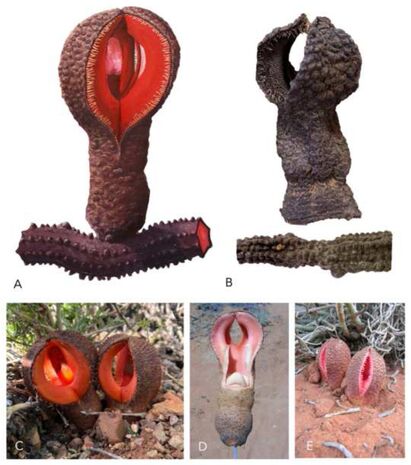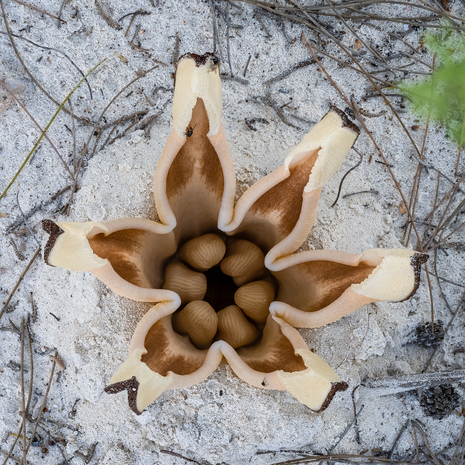Hydnora esculenta is a remarkable parasitic plant native to Africa, known for its unusual underground growth, unique reproductive strategies, and diverse applications in traditional medicine and skincare. As a member of the Hydnoraceae family, this plant relies entirely on its host for nutrients, making it one of the most intriguing botanical species.
Despite its parasitic nature, Hydnora esculenta holds significant ecological and cultural value. It has been utilized for centuries by indigenous communities for medicinal, culinary, and skincare purposes. This article explores the taxonomy, morphology, ecological role, medicinal properties, and culinary significance of Hydnora esculenta, while optimizing for SEO best practices by incorporating relevant keywords.

Scientific Name: Hydnora esculenta
Family: Hydnoraceae
Order: Piperales
Habitat: Semi-arid and arid regions of Southern Africa
Parasitic Host Plants: Primarily parasitizes roots of Euphorbia species
Unlike most flowering plants, Hydnora esculenta spends most of its life underground, with only its fleshy, trap-like flower emerging above the soil surface. The plant exhibits several unique adaptations:
Parasitic Adaptation:
Completely lacks chlorophyll and relies on host plants for nutrients.
Forms specialized haustoria that penetrate the roots of its host to extract water and nutrients.
Flower Structure and Pollination:
The flower emits a foul odor, mimicking decaying organic matter to attract carrion beetles and other pollinators.
The flowers have a fleshy, reddish-brown perianth, which acts as a trap for insects, facilitating pollination.
Fruit and Seed Dispersal:
Produces large, fleshy fruits, rich in nutrients and attractive to various animals.
Baboon, jackal, and other foraging mammals consume the fruit, aiding in seed dispersal.

Despite being a parasitic plant, Hydnora esculenta plays an essential role in its ecosystem:
Nutrient Cycling: By extracting resources from its host, it redistributes nutrients within the soil.
Pollination Network: It supports local insect populations, especially beetles, by providing a food source.
Wildlife Food Source: Its fruit is consumed by several animal species, contributing to seed dispersal and biodiversity.
For centuries, Hydnora esculenta has been an integral part of African traditional medicine. Scientific research and ethnobotanical studies have confirmed its medicinal properties, primarily due to its high tannin content and bioactive compounds.
Skincare and Dermatological Applications:
Crushed roots and fruit are used by the Xhosa people to create a red-colored paste, applied to the skin for treating acne and pimples (Dold & Cocks, 2005).
Acts as a natural sunscreen, commonly used by outdoor workers to protect the skin from harsh UV rays.
Gastrointestinal and Digestive Health:
The rhizome extract is traditionally used to treat diarrhea, dysentery, and constipation (Olajuyigbe & Afolayan, 2012).
Helps relieve intestinal inflammation and supports gut health.
Antimicrobial and Anti-inflammatory Properties:
Contains tannins, flavonoids, and alkaloids, which exhibit antimicrobial activity against bacterial and fungal infections (Bisi-Johnson et al., 2010).
Used to treat throat infections, glandular swelling, and oral thrush (De Beer & Van Wyk, 2011).
Cardiovascular and Systemic Benefits:
Extracts have been linked to blood pressure regulation and cardiovascular health (Omoruyi et al., 2012).
Potential use in managing hypertension, fever, and asthma (Otang et al., 2012).

Beyond its medicinal benefits, Hydnora esculenta is also considered a wild edible plant, enjoyed by indigenous communities:
Edibility: The fruit is sweet, juicy, and nutrient-rich, often compared to melon or apple in taste.
Historical Consumption:
The Nama people have been known to consume it (Gerstner 6309 [PRE0369198]).
In 1934, Vaccaneo recorded that Khoikhoi people ate the fruit both raw and roasted (Visser, 1981).
Wildlife Foraging: Frequently eaten by baboons, jackals, and other mammals, playing a crucial role in natural seed dispersal.

Recent scientific interest in Hydnora esculenta has led to pharmacological studies exploring its potential benefits:
Antioxidant Potential: High tannin levels indicate strong antioxidant activity, which may contribute to anti-aging and skincare applications.
Anti-cancer Properties: Preliminary studies suggest potential anticancer compounds that may inhibit the growth of esophageal cancer cells.
Antibacterial and Antifungal Research: Promising results in studies targeting pathogenic bacterial and fungal strains.

Given its ecological and medicinal significance, there is growing interest in sustainable harvesting and conservation efforts for Hydnora esculenta. Researchers are working to:
Understand host-plant relationships to develop sustainable cultivation practices.
Promote traditional knowledge while ensuring ethical and sustainable use.
Encourage conservation efforts to prevent habitat loss due to climate change and agricultural expansion.
Hydnora esculenta is more than just a parasitic plant—it is a botanical marvel with extensive medicinal, ecological, and culinary value. From its unique underground growth and intriguing pollination strategy to its role in traditional medicine and skincare, this plant continues to captivate scientists, herbalists, and ecologists alike.
With increasing research into its bioactive compounds and pharmacological applications, Hydnora esculenta may soon gain global recognition as a valuable medicinal and cosmetic resource. As conservation efforts progress, it is crucial to preserve this remarkable species while further exploring its potential benefits
animal tags: Hydnoraceae
We created this article in conjunction with AI technology, then made sure it was fact-checked and edited by a Animals Top editor.